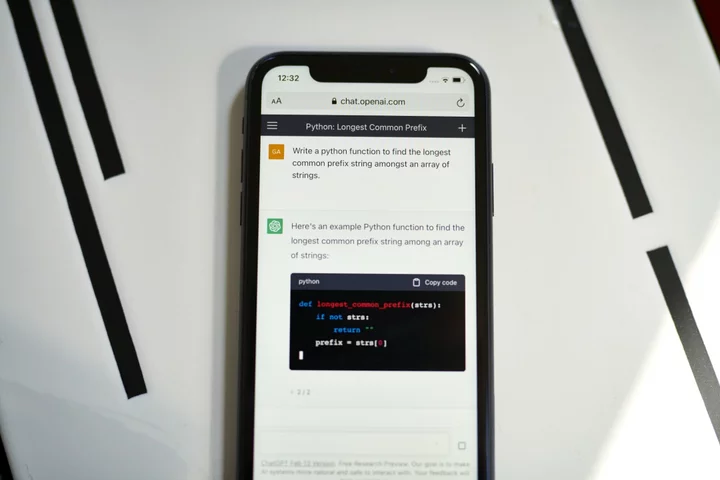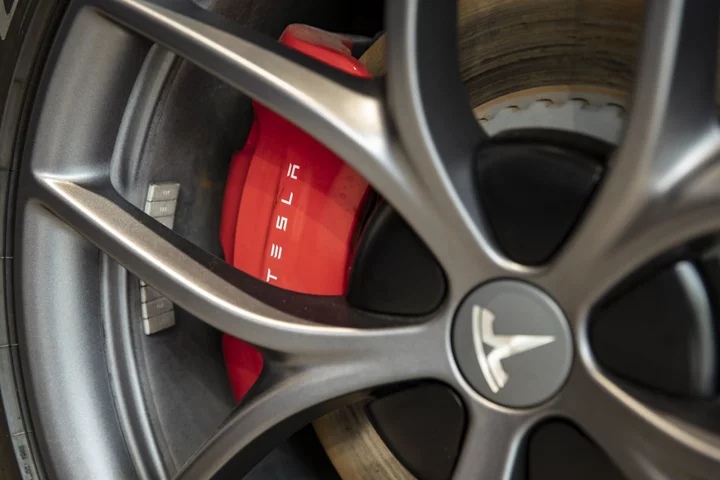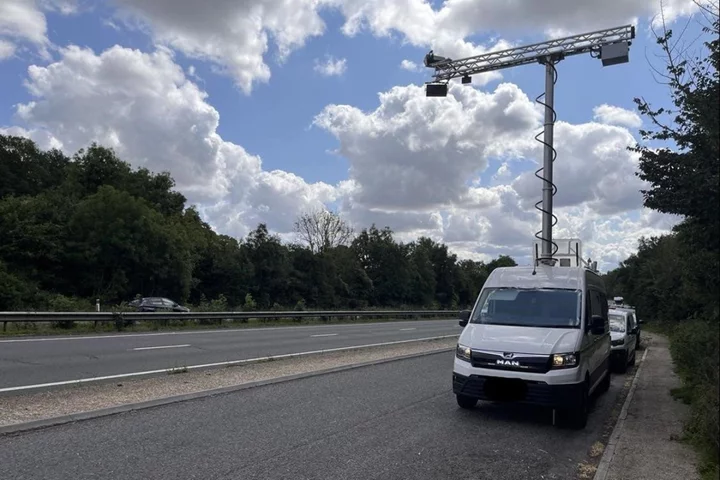
Rogers Lifts Outlook on Shaw Deal, Canada Population Boom
Rogers Communications Inc. raised its outlook for the year, as Canada’s high immigration levels helped the company show
1970-01-01 08:00

AT&T Tops Profit, Cash Flow Estimate While Customer Growth Slows
AT&T Inc. reported profit and free cash flow that topped analysts’ estimates, offering a brighter picture as the
1970-01-01 08:00

Study reveals the best exercises to lower blood pressure
A study has found the best exercises to lower blood pressure, so get ready to go to the gym. Research published in the British Journal of Sports Medicine and conducted at Canterbury Christ Church and Leicester universities, compared the efficacy of different forms of exercise on reducing blood pressure and found that “isometric exercises” – which involve engaging muscles without moveme are your best bet. That means it is time to hold a wall-sit, or plank for ages. Fun times. The study examined 270 randomised controlled clinical trials, involving 15,827 participants, on the effects of different types of exercise on resting blood pressure. It even found that these isometric techniques were almost twice as effective as government recommended exercises, aerobic activity like cycling and walking, though they found these other forms of exercise were effective too. Reducing blood pressure reduces your chance of stroke, heart failure, and other issues. Sign up to our free Indy100 weekly newsletter Over-40s are advised to have it checked every five years. Treatment often involves medication but patients are also advised to eat healthily, reduce alcohol intake, stop smoking and exercise regularly. Jamie O’Driscoll, a reader in cardiovascular physiology at Canterbury Christ Church university and senior author of the report, said in isometric exercises the muscle remained contracted but did not change in length. This static contraction could squeeze the vessels that supplied blood to the working muscles – which reduced the flow of blood to the muscle during the exercise and therefore oxygen supply to the muscle. When the muscle relaxed afterwards, it caused a large flow of blood through the vessels (this was different to other modes of exercise) and was likely to be the trigger driving these greater improvements in blood flow regulation. “Performing 4 x 2 minutes of wall sits, with 2-minutes’ rest in between, three times per week, is an effective way to reduce your blood pressure,” said O’Driscoll. “They should be done alongside other exercise modes, to provide the maximum range of exercise choices rather than limiting them.” Dr Kush Joshi, a sports and exercise medicine consultant and fellow of the Faculty of Sport and Exercise Medicine, welcomed the study’s findings, but questioned how easy it would be for patients to do. “The reality is a significant proportion of the population will not be able to do a plank or wall sits, and furthermore may not enjoy these types of activities,” he said. “Solutions need to be found to make these exercises accessible to all individuals with elevated blood pressure, and the study should provide impetus to policymakers to make exercise the bedrock of treatment of not only high blood pressure but other medical conditions and so to reduce the burden of medication for the population.” Joanne Whitmore, a senior cardiac nurse at the British Heart Foundation, said it was encouraging to see the benefits of other forms of exercise, as well as aerobic exercise. “We know that those who take on exercise they enjoy tend to carry on for longer, which is key in maintaining lower blood pressure.” But she said it was important to make lifestyle changes too, such as losing weight, eating more healthily and reducing alcohol consumption. Have your say in our news democracy. Click the upvote icon at the top of the page to help raise this article through the indy100 rankings.
1970-01-01 08:00

In Phoenix Heat, Ice-Filled Body Bags Are a Life-Saving Technology
As temperatures hit 119F in Phoenix last Thursday, doctors at Valleywise Health Medical Center saw a patient whose
1970-01-01 08:00

AI Leaders Create Industry Watchdog as Government Scrutiny Grows
Facing calls to put guardrails on artificial intelligence development, a group of tech companies including Alphabet Inc.’s Google
1970-01-01 08:00

The truth behind the viral Barbie Burj Khalifa video
With the release of the Barbie movie, different places around the world have been getting pink makeovers - including the Burj Khalifa. In a 12-second clip that has gone viral, stands a huge Barbie doll next to the world's tallest building located in Dubai, United Arab Emirates. The larger-than-life doll can be seen sporting an outfit that directly references her 1959 debut - wearing a striped romper with her blonde locks in a ponytail (which is also an outfit Margot Robbie wore in the film too). Sign up to our free Indy100 weekly newsletter During the video, Barbie stood inside her very own hot pink box and then broke through the plastic cover to step out onto the city street. The CGI clip was posted by boutique creative agency, Eye Studio (@eyestudioae) and took around three days to make, using footage of the Burj Khalifa shot from an iPhone, before the big 3D Barbie was superimposed into the video. "As a social media agency, we're always thinking about what's trending, and everyone is currently talking about Barbie," Juhi Rupani, Eye Studio's creative director told The National. "So we thought of doing something around an iconic product and putting her next to the most iconic landmark in Dubai." After deciding on the concept, 3D generalist Neal Santos, and junior art director, Taha Dungerwala helped to make the vision come alive. "The first thing that crossed our mind while making it was we kind of wanted to pay homage to the beginning and stay close to how the very first Barbie doll ever created looked back in 1959," they told the same publication. "When it came to location, after going back and forth we decided nothing beats the Burj Khalifa." Meanwhile, Barbie is the biggest debut ever for a film directed by a woman, with the Greta Gerwig film making $356m (£276m) around the world opening weekend. Have your say in our news democracy. Click the upvote icon at the top of the page to help raise this article through the indy100 rankings.
1970-01-01 08:00

Snap Shares Drop After Sales Forecast Misses Estimates
Snap Inc. projected revenue at the lower end of analysts’ estimates for this quarter, signaling that improvements to
1970-01-01 08:00

Alphabet Shares Gain on Revenue Beat From Google Search
Google parent Alphabet Inc. reported second-quarter revenue that exceeded analysts’ expectations, boosted by advertising on the company’s flagship
1970-01-01 08:00

Teen influencer Milla Sofia flooded with 'creepy' comments despite her not being real
Artificial intelligence has struck again, and this time, it's somehow got the internet obsessing over a jet-setting influencer who doesn't even exist. Milla Sofia is a 19-year-old "robot girl" from Helsinki who works as a fashion model and now boasts over 30,000 followers on Instagram. Her page showcases hyper-realistic selfies and photo montages of her travels across the world, including the likes of Paris, Australia and Santorini. "I bring an unparalleled and futuristic perspective to the realm of style," her creator wrote on her website. "Whether it's the catwalk or the digital landscape, my passion lies in showcasing the latest trends and pushing the boundaries in the ever-evolving fashion industry." Disturbingly, her posts are often flooded with comments from thirsty men who have either not figured out Milla's AI-generated, or simply have no shame. "Well you look fabulous wearing anything as well as nothing I’m sure. Your a beautiful young woman," one man wrote, while another gushed: "Beautiful lady. Your eyes dreams colour, your hair colour and your dress colour are beautiful." Sign up for our free Indy100 weekly newsletter "There's a perfect woman," a third added, which prompted one person to quip back: "All these dumb people that think she is real. Actually terrifying how disconnected you all are from reality." It comes after socially starved cryptobros fork out thousands for NFT girlfriends, which are essentially inanimate digital paintings costing up to $100,000. One man, a self-proclaimed "digital pimp", was initially attracted to the idea of "owning his very own exclusive girlfriend" who he can spend quality time with whenever he wanted. "I got a printout of the NFT which I display on my wall, right above where I work as a reminder of what a great purchase she was," he explained. In what he described as a "weird concept", Jake confessed that his involvement with NFT girlfriends made him feel like a "pimp" following the motto of: "If you want my girl, you've got to pay!" Have your say in our news democracy. Click the upvote icon at the top of the page to help raise this article through the indy100 rankings.
1970-01-01 08:00

Tesla Cars Barred From World University Games Ahead of Xi Visit
Tesla Inc. vehicles are barred from parts of a major Chinese city as it prepares for a visit
1970-01-01 08:00

Police use AI camera van to spot drivers using mobile phones
A police spy camera van which uses artificial intelligence (AI) to detect drivers using their mobile phones at the wheel and not wearing seat belts has led to nearly 500 driving offences being identified. Hampshire and Thames Valley Police forces targeted commercial vehicles in a week-long operation on the A34 and the A303 using the Sensor test vehicle with the Acusensus “Heads-up” solution provided by infrastructure consultancy AECOM. The AI-equipped camera van can detect drivers using their phones using two cameras. The first is set at a shallow angle to identify a mobile phone close to the driver’s ear as well as spot whether a seat belt is being worn, and the second has a steep view to see if a mobile phone is being held down in front for texting. Once the offences are identified by the AI system, the results are double-checked by at least two humans before being considered for prosecution. Simon Gomer, manager of the police forces’ Safer Roads Unit, said: “These are very exciting times and this has been a great opportunity for both forces to utilise the latest in AI technology. “But the results we’ve had from just one week sadly show how prolific these offences are. We will continue to spread the message that distracted driving kills, these offences will be punished and social habits need to change.” Dr Jamie Uff, of AECOM, said: “Despite the often-reported dangers of distracted driving and failing to wear seat belts, the numbers of people killed or seriously injured as a result of these behaviours remain high. “The technology AECOM is deploying makes detection straightforward and is providing valuable insight to the police and policy makers on the current level of road user behaviour. We are really keen for the use of this technology to be expanded to raise awareness and improve road safety for everyone.” The Heads-up van identified 86 drivers suspected of using a phone and 273 motorists or passengers suspected of not wearing a seat belt, with a further 132 mechanical offences identified. Five arrests were also made for offences such as drug-driving and disqualified driving. Police Sergeant Paul Diamond, of the Commercial Vehicle Unit, said: “It is always disappointing to see the level of danger some people bring to themselves and other motorists, but with dedicated operations like this we can combat the threat and remove the worst offenders.” Read More Charity boss speaks out over ‘traumatic’ encounter with royal aide Ukraine war’s heaviest fight rages in east - follow live
1970-01-01 08:00

Yi Gang Ends PBOC Governor Tenure Marked by Restrained Policy
Yi Gang ends a five-year tenure at the helm of China’s central bank that’s been marked by a
1970-01-01 08:00
